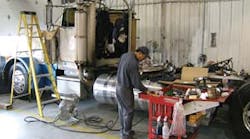In today’s demanding and tough economy, fleet maintenance managers are experiencing even greater amounts of pressure to stay within budget, control costs, manage vehicles effectively throughout their lifetime and operate vehicles and shops as efficiently as possible. These challenges are on top of rising vehicle, shop equipment and tool costs and complexity.
Higher performance can be achieved by identifying the most important aspects of the fleet and maintenance operations, measuring them, using this information to evaluate the operation and then incorporating practices and methods to more efficiently and effectively manage the various targeted functions.
The more successful vehicle maintenance managers say the first step is to take stock of the operation, identify the critical drivers and true costs and figure out what it does and does not do well. This is where financial management, particularly such elements as life cycle analysis, cost analysis and benchmarking can be a great help as fleets attempt to do more with less.
Such financial management tools are effective for accurately determining true ownership economics and the most favorable replacement intervals by taking into account the total cash flow associated with the total life of an asset. This involves consideration of such things as purchase price and depreciation, insurance cost, cost or use of money, licensing and registration, driving patterns and mileage, fuel economy, scheduled maintenance, unscheduled maintenance and repair costs, future replacement values and residual values.
Having the real cost of each asset, along with historical data, also helps in making more informed decisions on whether to replace an asset, keep repairing it, rebuild it or change component specifications to lower the total cost of ownership.
LIFE CYCLES
Life cycle analysis should be performed regularly, with resale value being a consideration, especially when it comes to vehicles, advises Tony Vercillo, president of supply chain, distribution, fleet management and logistics consulting company IFMC. “Every piece of equipment has a highly predictable economic life that is very different from its useful life,” he says. “It may pay to shorten equipment life in order to get a higher resale value, rather than running it for say 10 years and getting nothing for it.”
Vercillo says the key to vehicle life cycle analysis is managing the three phases of ownership: acquisition and in-service inspection, cost of use over the life cycle and disposition costs (resale, damages, etc.).
He suggests using his 4 R Strategy which involves answering the following question: Which of these four alternatives is cheaper and makes the most sense for your company?
Should we run it as is for one more year?
Should we spend money, repair it and run one more year?
Should we completely rebuild it and run it for five more years?
Should we replace the asset?
The objective, says Vercillo, is to determine if it is better, from a cash-flow perspective, to sell-off assets earlier and recapture funds rather than hold-onto assets until they become boat anchors.
Spare assets need to be considered as well, he adds. Does it make sense to have them, especially if there are not being used regularly or at all? In the case of vehicles, there are still insurance, compliance and other expenses.
Vercillo points out there a number of models that can be used for life cycle costing and cost analysis, from simple Excel spreadsheets to sophisticated fleet management and maintenance software programs that can keep track of each asset and the to-date costs associated with it.
BUSINESS MEASURES
As would be expected, records of asset utilization and maintenance and repair costs, labor time, parts use, consumables, fuel use, etc., are the foundation to sound financial management. The better the recordkeeping, the better the intelligence to make good, cost-effective decisions on purchasing, maintaining and replacing assets.
For recordkeeping to be the most useful, notes Vercillo, there must be consistency in continually tracking this data.
Benchmarking is the process of measuring an operation’s processes, then identifying, understanding and adapting practices from other organizations that are widely considered to be an industry standard or best practice. When correctly done, benchmarking can help cure weaknesses in a company’s operations by providing a snapshot of the performance of its operation and helping management understand where the operation is in relation to best practices so performance improvements can be made.
A key objective, say successful vehicle maintenance managers, is to figure out which functions hold the greatest opportunity for improvement. For example, areas such as preventive maintenance, service and reliability management. Once this is determined, the appropriate measures to benchmark need to be decided. Then, operations need to be found that show excellence in each of the functions targeted for improvement.
Benchmarking activity should not be limited to one’s own industry, says Vercillo. While important, most companies already have a pretty good idea how their industry performs. Going outside to other industries that perform similar processes can often provide good insight and ideas for organizational and business process improvement.
A learning path
Financial management can be a great aid to fleet and maintenance managers for a number of reasons, says Ruth Alfson, CAFM, fleet manager, fleet center of excellence, with the Serco Group, a leading provider of professional, technology and management services focused on the federal government. Along with being able to better manage capital assets, having a good grasp of financial management can also help make a more convincing case for new purchases or replacements.
Financial management is one of the eight major topics addressed as part of the NAFA Fleet Management Association’s Certified Automotive Fleet Manager (CAFM) Program. The oldest and largest fleet certification in the world, CAFM is the only program that attests to one’s expertise in the profession.
NAFA is a not-for-profit, individual membership professional society that serves the needs of members who manage fleets of all types of vehicles and mobile equipment for organizations across the globe.
The financial management program covers basic accounting principles, life cycle costs, cost analysis and much more, says Alfson, who got her CAFM certification in 1996 and has been involved with the program since, and in particular, with the finance management curriculum.
As for vehicle and maintenance life cycles and costing, the course covers how to identify the various elements involved - such as purchase price and depreciation, insurance cost, driving patterns, fuel economy, scheduled maintenance, unscheduled maintenance and repair costs, she says. The course then moves into how to actually do the calculations, based on an estimated useful term or based on mileage or age of vehicle.
Business economic analysis tools are taught for comparing the relative merit of alternatives that eliminate assumptions and guesswork. In addition, there are modules on how to link all this to strategic planning for vehicle replacement and fleet expansion.
The overall objective of the CAFM financial management course, says Alfson, is to teach how to figure overall vehicle ownership economics, how to set up an effective lifecycle costing program and how to communicate the findings to others within an organization.
SOFTWARE SYSTEMS
Fleet management and maintenance software are available that provide the tools necessary to efficiently collect the data required to figure the true cost of vehicle operation and perform life cycle analysis.
This data can then be analyzed to determine significant expense milestones over the life cycle of an individual vehicle, a group of vehicles, a vehicle type or class or an entire fleet, based on time or utilization, says Dave Walters, technical sales manager for TMW Systems. The company is a developer of enterprise management software for the surface transportation services industry, including logistics, trucking and heavy duty repair and maintenance.
“Operational and maintenance data, when combined with outside influences such as technology changes, trade values, mpg capabilities, replacement cost and utilization can be the foundation for determining optimal economic replacement times and repair-vs-replace decisions,” he says.
The information is often used as inputs into a spreadsheet process that does the analysis, observes Marc Knight, associate director of business solutions for AssetWorks, a provider of software solutions for infrastructure-intensive organizations in education, government, utilities, communications and transportation.
“Managers would run the reports, in many cases exporting the data into a spreadsheet and then use that in their analysis,” he says. “More recently, you are starting to see fleet applications develop integrated replacement analysis tools that eliminate the need to do the analysis in a spreadsheet.”
AssetWorks FleetFocus products, for example, have a Replacement Candidates process that uses historical detailed data to prioritize vehicles for replacement. Using proprietary algorithms in conjunction with user selected and weighted priority factors, the fleet management software application scores each unit and ranks them to aid managers in determining which units to select for replacement.
Software functionality also exists to help users plan for the replacement of equipment and supports work-flows to track the approval of replacement nominees, the disposal of the old unit and the acquisition of new assets, adds Knight. “This level of functionality has lifted fleet applications from being just maintenance systems into full fleet management systems.”
IMPORTANT ELEMENTS
The primary considerations when looking for software to help with overall vehicle life cycle evaluation is “the ability to efficiently collect data in a format that allows the user to sort and analyze the results,” TMW Systems’ Walters says. “A good software solution should provide the ability to assign unit types and group units in subsets or fleets for tracking purposes.”
“Users should also look for a system that maintains a history by period for each asset which can be then aggregated into age and/or usage cohorts to identify what the costs are in year one, two, etc.,” says Knight. “A system should also have standard reports that can be used to support at least manual life cycle analysis. Better systems will have integrated replacement analysis and planning functions.”
Another key consideration is whether the software program has a “robust” warranty management and tracking system, Walters says. How warranty is tracked and accounted for is important, as is the ability to track major component replacement and having in-trade analysis.
Beyond that, he says a software program should maintain a standard data reporting format, such as ATA’s VMRS (Vehicle Maintenance Reporting Standards), plus have advanced reporting capabilities, along with the ability to set data thresholds and create alerts when data falls outside of established parameters, design key performance indicators and monitor data in real-time.
All this can be done with TMW Systems’ TMT Fleet Maintenance software, notes Walters. It also provides the ability for metrics to be established with a fleet’s specific requirements as they pertain to vehicle trade-in and repair vs replace decisions.
ACTION PLANS
Life cycle costing, cost analysis, benchmarking and other financial management tools help create the context for identifying areas for improvement and establishing performance measures. Just gathering information is not enough, though, it must be used.
The real benefits do not occur until the findings are implemented and improvements are realized, says GenesisSolutions’ Wireman.
“Perhaps the most important thing to remember is to be sure to use the results,” Vercillo adds. “Too many companies go to the trouble of doing all the analyses and then either do not trust the results, or worse, decide not to use them.
“Do your homework and spend the appropriate amount of time ensuring an apples-to-apples comparison. Then, implement initiatives that make a difference.”
When used effectively, the mined data can help maintenance managers develop action plans that set goals and objectives to improve performance, productivity and profitability. For long-term results, there needs to be an ongoing process of monitoring, reassessing and revising action plans.




